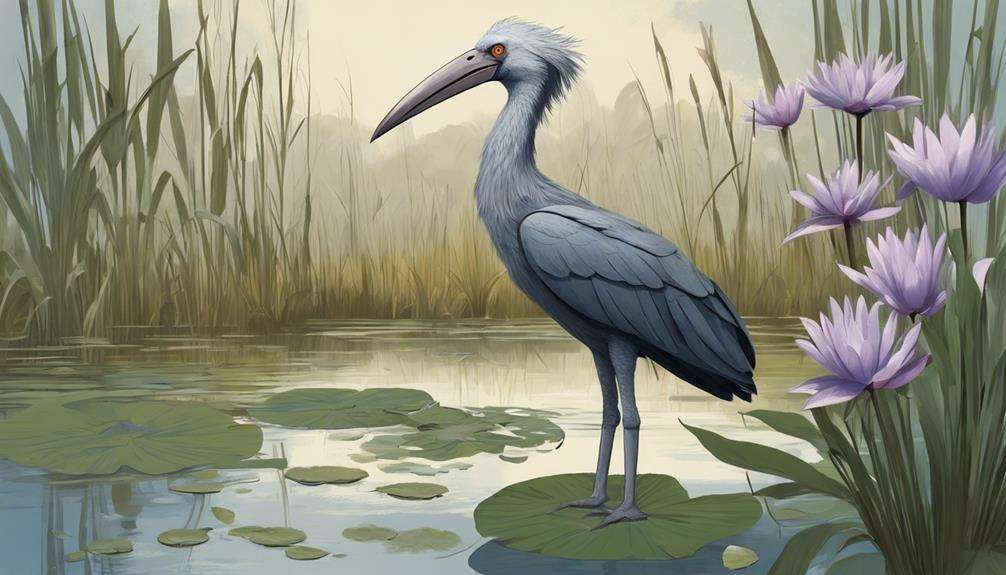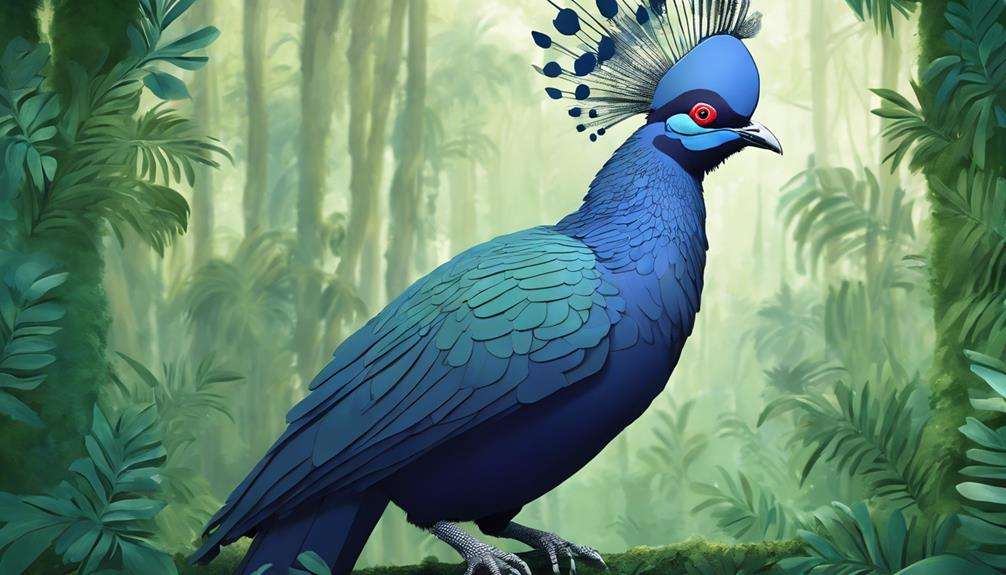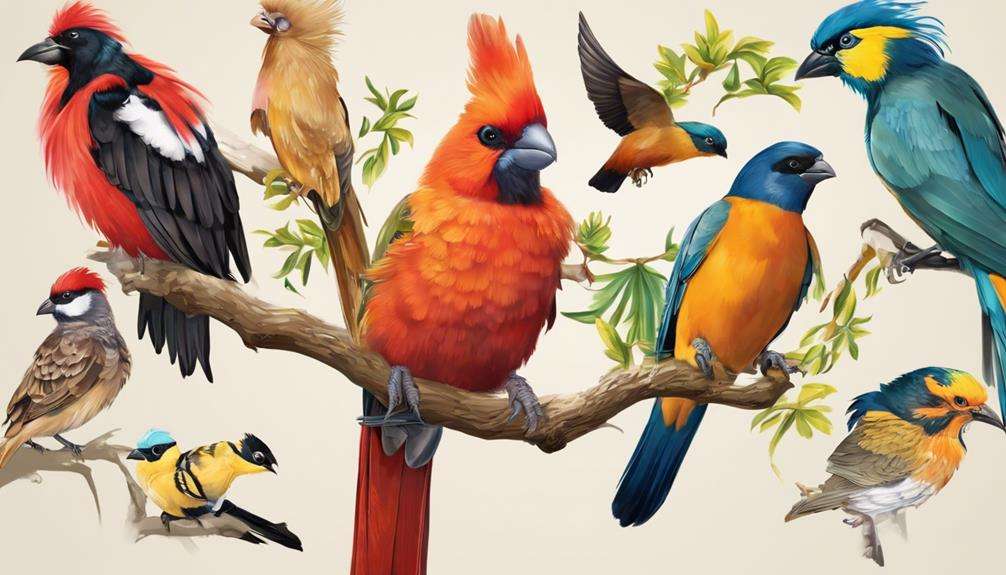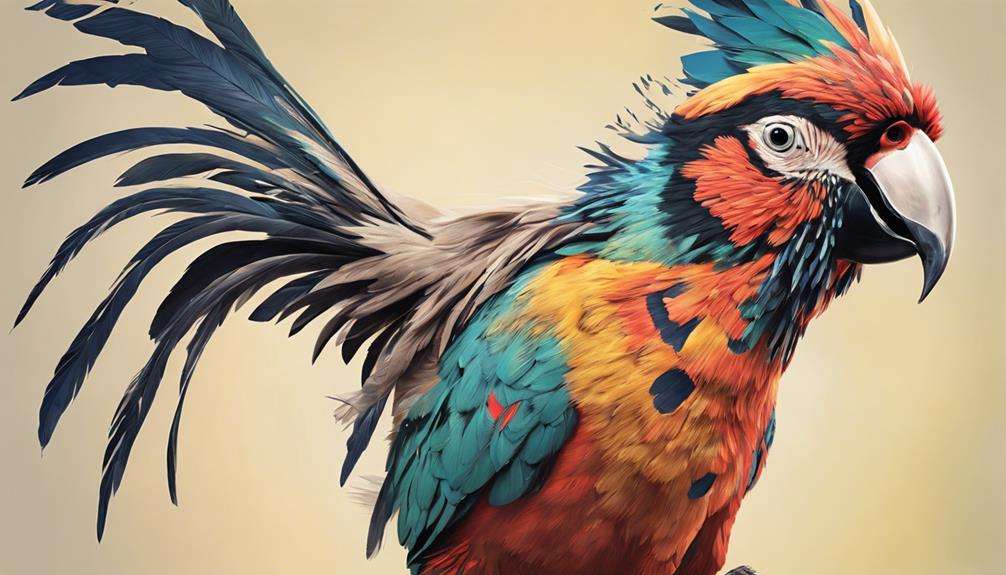Exploring the world of avian species opens up a world of wonder, where each bird's unique traits and behaviors can enchant your imagination. From the majestic Harpy Eagle's impressive hunting skills to the vibrant plumage of the Sun Conure, there's a diverse array of fascinating avian species waiting to be discovered.
As you uncover these remarkable birds, you'll find yourself drawn into a domain where nature's beauty knows no bounds. Intrigued to learn more about these enchanting creatures and the secrets they hold within their wings?
Key Takeaways
- Conservation efforts crucial for endangered avian species survival
- Unique avian features like impressive wingspans and vibrant plumage
- Avian habitats play vital roles in ecosystems and seed dispersal
- Geographic distribution showcases diverse and distinct avian species
Majestic Harpy Eagle
Nestled within the lush canopies of Central and South American rainforests, the Majestic Harpy Eagle reigns as one of the largest and most powerful eagles globally, boasting a formidable wingspan that can span up to 7 feet.
This apex predator is known for its hunting techniques, where it stealthily observes its prey from high perches before swooping down with precision, using its powerful talons to catch animals like sloths and monkeys. The Harpy Eagle is also territorial, fiercely defending its nesting sites from intruders, showcasing its nesting behavior by constructing large nests high up.
Regarding reproduction, the Harpy Eagle follows a meticulous cycle, with mating pairs bonding for life. They engage in elaborate courtship displays, strengthening their bond through intricate aerial maneuvers. The female lays one or two eggs, with both parents taking turns to incubate them.
Conservation efforts are critical to protect this magnificent species from threats like habitat loss and hunting, ensuring the continuation of this remarkable bird's existence in the wild.
Colorful Quetzal Bird
You'll be captivated by the vibrant iridescent green and red plumage of the Quetzal bird, a species that thrives in the cloud forests of Central and South America.
Its long, flowing tail feathers, often growing up to 3 feet long, symbolize beauty and grace, making it a majestic sight to behold.
Conservation efforts are vital to protect the Quetzal's habitat and secure the survival of this stunning species for future generations.
Quetzal Bird Habitat
Inhabiting the misty cloud forests of Central America, the Quetzal bird stands out with its vibrant iridescent plumage, making it an alluring sight for bird enthusiasts. These endangered species are important to the ecosystem of countries like Guatemala, Costa Rica, and Panama, where they aid in seed dispersal by feeding primarily on fruits like avocados and figs.
The cloud forest provides the perfect habitat for the Quetzal, offering a diverse range of fruits and a misty atmosphere that the birds prefer. Conservation efforts are essential to protect these unique creatures and their habitat, ensuring that future generations can continue to marvel at the beauty of the Quetzal in its natural environment.
Unique Feathers Display
The vibrant iridescent plumage of the Quetzal bird, specifically its stunning green and red feathers, captivates observers in the forests of Central and South America. The feather coloration of the Quetzal serves an evolutionary significance, aiding in attracting mates and camouflaging in their lush habitats.
These birds are also distinguished by their long tail feathers, which can grow up to an impressive three feet in length. During mating rituals, male Quetzals showcase their colorful plumage and perform intricate aerial displays to court females. This unique courtship behavior highlights the importance of their vibrant feathers in the species' reproductive success.
The Quetzal's striking appearance not only mesmerizes onlookers but also plays a crucial role in their survival and propagation.
Conservation Efforts Needed
Conservationists urgently need to address the threats faced by the colorful Quetzal bird, particularly focusing on habitat preservation and anti-poaching measures.
Habitat preservation is essential to safeguard the Quetzal bird's existence, as deforestation encroaches on its cloud forest homes. Engaging local communities in conservation efforts is necessary to guarantee sustainable practices that protect the bird's habitat.
Implementing anti-poaching measures is crucial to combat illegal hunting, which poses a significant risk to the Quetzal population. By promoting sustainable tourism practices that benefit both the local communities and the bird, conservation partnerships can be forged to support the long-term protection of the Quetzal species.
Collaborative efforts are key to preserving the Quetzal bird and maintaining the biodiversity of the cloud forests it calls home.
Elusive Kakapo Parrot
Elusive and enigmatic, the Kakapo parrot, also known as the 'owl parrot,' captivates with its rare presence and intriguing behaviors. Endearing kakapo antics, such as their playful nature and comical mating rituals, add to the allure of this critically endangered species. Kakapos, with their mossy green plumage and endearing chubby appearance, have a habitat restoration program dedicated to preserving their native environment in New Zealand.
Kakapos, being nocturnal herbivores, forage for native plants, fruits, seeds, and leaves under the cover of darkness. Their large size and unique mating behavior, lekking, contribute to their distinctive charm. With only about 200 individuals left in the wild, conservation efforts play a pivotal role in safeguarding these iconic birds.
Despite their dwindling numbers, kakapos remain friendly and curious, endearing themselves to bird enthusiasts and conservationists globally. Their captivating presence and urgent conservation needs make them a symbol of hope and resilience in the face of extinction.
Striking Shoebill Stork

You notice the Shoebill Stork's distinctive shoe-shaped bill, perfectly adapted for snatching fish and small reptiles from the wetlands of East Africa.
Its towering height of up to 5 feet and an impressive 8-foot wingspan command attention as it patiently stalks its prey.
The conservation of this magnificent species is important due to threats like habitat loss and hunting in certain regions.
Unique Physical Features
Characterized by its strikingly large shoe-shaped bill, the Shoebill Stork, also known as the 'whalehead,' captivates observers with its unique physical features in the swamps of central tropical Africa.
The Shoebill Stork's anatomy includes a towering stature of up to 5 feet, an impressive wingspan exceeding 8 feet, and a distinctively shaped bill perfectly designed for catching prey. These birds exhibit remarkable behavioral adaptations, displaying patience while hunting by remaining motionless for extended periods before swiftly striking their target with remarkable precision.
Despite their solitary nature, Shoebill Storks are skilled hunters with lightning-fast reflexes. Their preference for remote wetland habitats adds to their mystique, making them a prized discovery for birdwatchers excited to witness these majestic creatures in action.
Feeding and Behavior
With a keen eye and remarkable patience, the Shoebill Stork showcases its unique feeding behavior by standing still for hours before swiftly striking with its massive bill to catch prey.
This hunting strategy allows the Shoebill Stork to carefully select its prey, often focusing on fish, frogs, and small reptiles found in the marshy regions of central and eastern Africa.
The Shoebill Stork's specialized bill shape and size play an important role in its prey selection process, aiding in precise grabbing and efficient consumption.
Despite its large stature, this bird is a stealthy predator, relying on its sharp eyesight to detect potential meals lurking beneath the water's surface.
Through its patient and calculated feeding approach, the Shoebill Stork demonstrates its adaptability and survival skills in its wetland habitat.
Conservation Status
The remarkable Shoebill Stork, classified as Vulnerable by the IUCN, faces significant threats due to habitat loss, hunting, and disturbance in its wetland habitats. These majestic birds primarily inhabit marshes and swamps, relying on wetlands for their survival as they feed on fish and frogs.
Conservation efforts emphasize wetland preservation and community involvement to safeguard the Shoebill Stork's habitat. Initiatives promoting sustainable ecotourism and local engagement play an important role in raising awareness about the importance of protecting this unique species.
Vibrant Sun Conure

Amidst the lush canopies of South America, the vibrant Sun Conure shines brightly with its stunning yellow, orange, and red plumage. These small to medium-sized parrots are native to regions like Brazil, Guyana, and Venezuela. Known for their sociable nature, Sun Conures form strong bonds with their flock mates and human companions. When it comes to breeding habits, Sun Conures are known to be critical and often mate for life. They typically nest in tree cavities and lay clutches of 2-4 eggs, with both parents taking turns to incubate them.
Regarding vocalizations, Sun Conures are intelligent and playful birds that engage in acrobatic behaviors and communicate through loud, high-pitched calls. Their vocal repertoire includes various squawks, screeches, and chatters, which they use to express emotions, communicate with their flock, and establish territory.
Conservation efforts are essential for the Sun Conure as they face threats like habitat loss and illegal trapping for the pet trade. By understanding their breeding habits and vocalizations, we can better appreciate and protect these beautiful avian species.
Elegant Secretary Bird
In the vast savannas of sub-Saharan Africa, the Elegant Secretary Bird commands attention with its striking appearance and impressive hunting skills. Standing up to 4 feet tall, this bird of prey boasts long legs, a distinctive black crest resembling quill pens, and a hooked bill perfect for hunting. Secretary Birds are skilled predators, utilizing their powerful legs to stomp on prey like snakes and insects, covering impressive distances of over 12 miles a day.
These birds exhibit territorial behavior, often nesting in acacia trees and forming strong bonds with their mates. Secretary Birds are known for their monogamous relationships and the dedication they show to their partners. Their nesting habits reflect a sense of loyalty and commitment to their chosen mate.
While not currently classified as endangered, Secretary Birds face threats from habitat loss, poisoning, and collisions with power lines. Despite these challenges, the Elegant Secretary Bird continues to captivate with its grace, intelligence, and remarkable hunting prowess.
Graceful Victoria Crowned Pigeon

Amongst the lush rainforests of Papua New Guinea and its neighboring islands, the graceful Victoria Crowned Pigeon stands out as a striking symbol of beauty and elegance. This species is one of the largest and most beautiful pigeons, measuring up to 74 cm in length. With its blue-grey plumage, maroon breast, and elegant white-tipped crest on its head, the Victoria Crowned Pigeon is a sight to behold. These pigeons are native to the rainforests where they feed on fruits, seeds, and insects. They're known for their monogamous nature, forming strong pair bonds and sharing the responsibility of caring for their single egg and chick.
However, despite their popularity in aviaries, Victoria Crowned Pigeons face threats in the wild due to habitat destruction and hunting for their meat and feathers. Habitat destruction poses a significant risk to their survival, as deforestation continues to encroach upon their natural habitat, diminishing their breeding grounds and food sources. Conservation efforts are essential to protect these elegant birds from further decline.
Enigmatic Philippine Eagle
Standing tall in the dense tropical forests of the Philippines, the enigmatic Philippine Eagle commands attention with its impressive size and striking features. As one of the largest and most powerful eagles globally, boasting a wingspan of up to 7 feet, this critically endangered species is endemic to the Philippines, primarily inhabiting tropical forests. Known for its predatory nature, the Philippine Eagle, also referred to as the 'Monkey-eating eagle,' preys on monkeys, small mammals, birds, and reptiles.
Nesting behavior is a vital aspect of the Philippine Eagle's life cycle, with these majestic birds selecting large trees for nesting sites, where they raise their young and establish their territories. Habitat restoration plays a crucial role in the conservation efforts aimed at protecting these magnificent creatures from threats like deforestation and hunting. The Philippine Eagle's iconic appearance, characterized by its majestic crest and powerful beak, has made it a symbol of conservation in the Philippines, underscoring the importance of preserving its natural habitat.
Exotic Andean Cock-of-the-Rock
Observing the vibrant orange plumage and distinctive fan-shaped crests of the male Andean Cock-of-the-Rock is a mesmerizing experience in the cloud forests of South America. These striking birds are known for their elaborate courtship displays, which include intricate dances and vocalizations. During the breeding season, male Andean Cocks-of-the-Rock gather in leks to compete for the attention of females. They perform energetic dances, fluff their bright plumage, and call out loudly to attract a mate.
Their breeding habits are fascinating to witness as the males fiercely compete to establish dominance and win over a female partner. The vocalizations of the Andean Cock-of-the-Rock are loud and distinctive, echoing through the misty forests as part of their courtship rituals. These birds rely on their stunning appearance and enthralling performances to guarantee successful mating opportunities.
In addition to their impressive displays, Andean Cocks-of-the-Rock are frugivorous, feeding primarily on fruits and occasionally insects. However, habitat loss and deforestation pose significant threats to their survival, underscoring the importance of conservation efforts to protect this exotic species.
Frequently Asked Questions
What Is a Bird Enthusiast Called?
You're designated as a bird enthusiast in the ornithology terminology. Within the birding community, you're recognized as a birder or birdwatcher. Your passion for observing avian species makes you an essential contributor to citizen science projects and conservation efforts.
How Do You Become a Bird Watcher?
To become a bird watcher, start by investing in gear like binoculars. Join local groups, visit various habitats, and use apps for bird identification. Practice patience and observation. Enjoy bird behavior and migration while honing bird photography skills.
What Is the Most Unique Bird in the World?
The Kakapo, with its moss-green plumage and unusual behaviors like its inability to fly, stands out as one of the most unique birds globally. Its friendly demeanor and playful antics make it a conservation icon.
What Is the Website to Learn About Birds?
Looking to spread your wings in the vast world of bird knowledge? Head online for a beak-full of birding resources! Jump into websites like the Cornell Lab of Ornithology for excellent avian info.
Conclusion
As you gaze upon these magnificent avian species, you realize the intricate beauty of nature's creations. Each bird, with its unique colors and behaviors, holds a story waiting to be uncovered.
From the majestic Harpy Eagle to the elusive Kakapo Parrot, every feathered friend adds a touch of wonder to our world.
So go forth, bird enthusiast, and continue to explore, for there's always more to discover in the mesmerizing domain of avian species.






